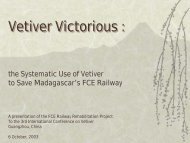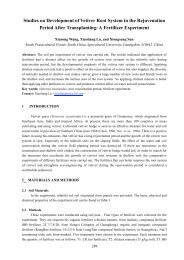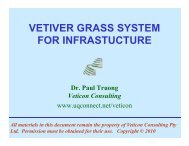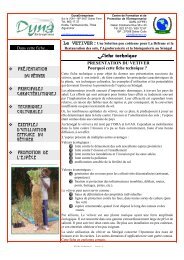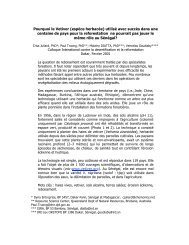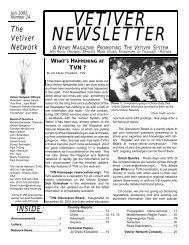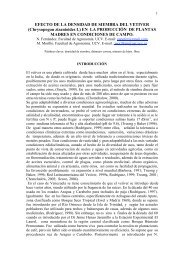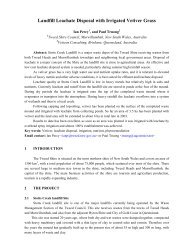Ecological Effectiveness of Vetiver Constructed Wetlands in Treating ...
Ecological Effectiveness of Vetiver Constructed Wetlands in Treating ...
Ecological Effectiveness of Vetiver Constructed Wetlands in Treating ...
You also want an ePaper? Increase the reach of your titles
YUMPU automatically turns print PDFs into web optimized ePapers that Google loves.
Table 1_Chemical characteristics <strong>of</strong> soil used <strong>in</strong> constructed wetlandspH Organic matter(g/kg)Total N(g/kg)Total P(g/kg)Total K(g/kg)Total S(g/kg)AvailableN(mg/kg)Available P(mg/kg)AvailableK(mg/kg)4.57 6.10 0.33 0.14 4.48 0.11 30.0 12.7 74.7The tested wastewater <strong>in</strong> the trial consisted <strong>of</strong> a highly concentrated wastewater (HCW) and a lowconcentrated wastewater (LCW). The former was the flotation wastewater, hav<strong>in</strong>g the highestconcentration <strong>of</strong> pollutants; the latter was HCW after hav<strong>in</strong>g been physically and chemically treated. Ofthe tested 4 herbaceous species, V. zizanioides, P. australis, and T. latifolia were collected from thenursery <strong>of</strong> South Ch<strong>in</strong>a Institute <strong>of</strong> Botany (SCIB), the first had been grow<strong>in</strong>g <strong>in</strong> the xeric environment,and the latter two <strong>in</strong> the hydrophytic one. L. articutala was collected from a na tural wastewater dischar g<strong>in</strong>gcha nnel beside the oil-shale waste dump <strong>in</strong> Maom<strong>in</strong>g, which ha d ver y similar chara cteristics to a n artificialwetland used for w astew ater purif ication.2.2_ Trial Designs and ArrangementsSimulated artificial wetlands were constructed <strong>in</strong> large earthen conta<strong>in</strong>ers, filled with wastewaterfor purification. Three water treatments (HCW, LCW, and clean water (CW)) and 4 plant treatments (V.zizanioides, P. australis, T. latifolia, and L. articutala) w ere used. In addition, 2 controls were <strong>in</strong>cluded <strong>in</strong>the trial, which were HCW wetland without plants and LCW wetland without plants. All treatments andcontrols had three replicates. Dur<strong>in</strong>g the trial period all the conta<strong>in</strong>ers were grown <strong>in</strong> open air under aframe which was covered by a large cloth canopy to prevent ra<strong>in</strong>water from enter<strong>in</strong>g the conta<strong>in</strong>ers.Large earthen conta<strong>in</strong>ers, 70 cm high and 90 cm <strong>in</strong> diameter, with an outlet dra<strong>in</strong> for each one onthe bottom were custom-made for the trial. Each conta<strong>in</strong>er was then filled with 87.1 kg (DW) <strong>of</strong> soil andthen was planted with 18 slips <strong>of</strong> one <strong>of</strong> the above 4 species. Due to the big differences <strong>of</strong> stem diameteramong different species, T. latifolia, P. australis, V. zizanioides, and L. articutala we re planted with 1 tiller,2, 3, and 5 tiller s, re spectively, <strong>in</strong> order to make each species have a similar biomass at plant<strong>in</strong>g. Prior toplant<strong>in</strong>g, their tops and roots were all pruned to 30 cm and 5 cm, respectively. After plant<strong>in</strong>g, clean waterwas loaded <strong>in</strong>to the pots until the water level was 10 cm higher than the soil surface. The survival rateswere recorded and dead slips were replaced after 15 days. Dur<strong>in</strong>g the period <strong>of</strong> establishment, clean waterwas added to the conta<strong>in</strong>ers once every 2–4 days to supplement water loss by evapo-transpiration. At theend <strong>of</strong> the 2 months establishment period, the soil was let to dry out. Then the 3 treatment waters wereloaded, 55 kg for each conta<strong>in</strong>er. Samples <strong>of</strong> wastewater were collected from the dra<strong>in</strong>s for chemicalanalysis 8 days after load<strong>in</strong>g. After each test all wastewaters were discharged and conta<strong>in</strong>ers were leftopen until the soil become almost dry, then the second and third batches <strong>of</strong> wastewater were loaded, andthe same operation as the first batch was repeated 8 days after each batch <strong>of</strong> wastewaters was loaded. Thethree batches <strong>of</strong> wastewaters lasted <strong>in</strong> constructed wetlands from July 17 th –25 th , August 6 th –14 th , August21 st –29 th , respectively. Obviously, the experiment can be divided <strong>in</strong>to two stages: the stage <strong>of</strong> clean watercultivation, which was from May 4 th to July 16 th ; and the stage <strong>of</strong> treatment water cultivation, which wasfrom July 17 th to September 9 th .2.3_ Observations and Analysis2.3.1_Plant growth <strong>in</strong> wetlandsThe observation <strong>in</strong>cluded the survival rate, plant height and tiller number. The latter twoobservations were made twice, which were prior to load<strong>in</strong>g treatment water (July 16) and <strong>in</strong> the end <strong>of</strong> theexperiment (September 9), respectively.
cIssued by Guangdong Prov<strong>in</strong>cial Bureau <strong>of</strong> Environmental Protection on 20 August 20013.2_ Purify<strong>in</strong>g Benefits <strong>of</strong> <strong>Constructed</strong> <strong>Wetlands</strong> <strong>in</strong> the First Batch <strong>of</strong> WastewatersThe quality <strong>of</strong> the first batch <strong>of</strong> wastewaters after be<strong>in</strong>g treated <strong>in</strong> wetlands for 8 days is shown <strong>in</strong>Table 3, which <strong>in</strong>dicated that: 1) apart from a small rise <strong>in</strong> pH, all other pollutants dropped sharply, andfurthermore AN, VP, and benzene all reached the <strong>in</strong>strument measur<strong>in</strong>g lowest limits, and parts <strong>of</strong> BODand sulfide also reached their respective lowest limits; 2) compar<strong>in</strong>g HCW with LCW, the drop <strong>of</strong>pollutant levels was higher <strong>in</strong> the former than <strong>in</strong> the latter; and 3) the purify<strong>in</strong>g rates <strong>of</strong> wetlands were all<strong>in</strong> the order <strong>of</strong> AN > oil > BOD > COD, irrespective <strong>of</strong> the type <strong>of</strong> wastewaters, LCW or HCW. Thereasons for the highest purify<strong>in</strong>g rate for AN were probably due both to its strong volatility and the easytransformation feature <strong>in</strong>to nitrate N or N 2 (Xia et al., 2002). Kantawanichkul et al. (1999) also foundthat TKN and NH 3 -N was removed over 90% by constructed wetlands with V. zizanioides. It is<strong>in</strong>terest<strong>in</strong>g that the removal <strong>of</strong> AN was the lowest by us<strong>in</strong>g the physical and chemical method (Table 2),whereas it was the highest by wetland systems (Table 3). The removal rates <strong>of</strong> oil by constructedwetlands were also quite high, up to 89.8% <strong>in</strong> LCW and 95.3% <strong>in</strong> HCW. Ji et al, measured removalefficiencies <strong>of</strong> reed beds to m<strong>in</strong>eral oil were 88–96% (Ji et al., 2002). Another phenomenon <strong>in</strong> Table 3shows that treatments with plants had the almost the same purify<strong>in</strong>g efficiencies as those without plants(controls), which is revealed more clearly <strong>in</strong> Table 4.Table 3_Quality <strong>of</strong> the first batch <strong>of</strong> wastewaters after 8 days treatment <strong>in</strong> wetlands*Treatment pH AN COD BOD Oil Sulfide VP BenzeneWater quality and removal rates <strong>of</strong> HCWCK 8.51±0.16 0.5 32.1±4.4 4.1±0.7 1.80±0.09 0.11 0.02 0.005(97.7) (75.8) (90.0) (95.0) (38.9)V. zizanioides 7.57±0.05 0.5 30.9±5.9 4.4±1.1 1.30±0.37 0.11 0.02 0.005(97.7) (76.5) (89.3) (96.4) (38.9)T. latifolia 7.92±0.09 0.5 26.4±6.6 3.8±0.8 2.40±0.10 0.01 0.02 0.005(97.7) (80.3) (90.7) (93.3) (94.4)P. australis 7.86±0.18 0.5 31.7±1.1 3.3±0.4 0.85±0.07 0.03 0.02 0.005(97.7) (75.8) (91.9) (97.6) (83.3)L. articutala 7.82±0.15 0.5 23.5±3.3 2.0 2.10±0.15 0.07 0.02 0.005(97.7) (82.6) (95.1) (94.2) (61.1)Mean purify<strong>in</strong>g rate (%) 97.7 78.2 91.4 95.3 63.3 / /Water quality and removal rates <strong>of</strong> LCWCK 8.10±0.05 0.5 26.0±5.4 2.8±0.1 0.55±0.02 0.02 0.02 0.005(97.1) (70.1) (65.9) (90.8) (75.0)V. zizanioides 7.82±0.22 0.5 28.5±2.7 2.0 0.93±0.07 0.02 0.02 0.005(97.1) (66.7) (75.6) (84.5) (75.0)T. latifolia 7.96±0.27 0.5 24.6±2.0 2.0 0.77±0.10 0.01 0.02 0.005(97.1) (71.3) (75.6) (87.2) (87.5)P. australis, 7.59±0.11 0.5 27.7±1.4 2.0 0.31±0.02 0.02 0.02 0.005(97.1) (67.8) (75.6) (94.8) (75.0)L. articutala 7.88±0.11 0.5 16.4±4.2 2.0 0.51±0.03 0.02 0.02 0.005(97.1) (81.6) (75.6) (91.5) (75.0)Mean purify<strong>in</strong>g rate (%) 97.1 71.5 73.7 89.8 77.5 / /a The units <strong>of</strong> all observed data (parts are means ± SD) are the same as those <strong>in</strong> Table 2; data <strong>in</strong> parentheses arepurify<strong>in</strong>g rates (%); mean purify<strong>in</strong>g rate is the average value <strong>of</strong> purify<strong>in</strong>g rates <strong>in</strong> each column; 0.5, 2.0, 0.01,0.02, and 0.005 are the <strong>in</strong>strument measur<strong>in</strong>g lowest limits <strong>of</strong> AN, BOD, sulfide, VP, and benzene,respectively. When the measured data are smaller than the <strong>in</strong>strument measur<strong>in</strong>g lowest limits, they are treatedas the <strong>in</strong>strument measur<strong>in</strong>g lowest limits.
The effectiveness <strong>of</strong> plants for pollutant purification <strong>in</strong> the present experiment was not so dist<strong>in</strong>ct <strong>in</strong>the beg<strong>in</strong>n<strong>in</strong>g <strong>of</strong> the experiment (Table 4). The net purified amounts com<strong>in</strong>g from plants were very low,and some <strong>of</strong> them were even negative, namely the purify<strong>in</strong>g effectiveness <strong>of</strong> the treatments with plantswas even poorer than controls. This was probably due to the relatively smaller biomass and the relativelypoorer adaptation to the wastewater environment at the beg<strong>in</strong>n<strong>in</strong>g. Table 4 also shows that there werealmost no significant differences among different species with regard to their purify<strong>in</strong>g efficiencies topollutants, except for parts <strong>of</strong> COD (P>0.05). Overall the purify<strong>in</strong>g effectiveness <strong>of</strong> L. articutala wa sslightly better compare d with other 3 species.Table 4_The net removal <strong>of</strong> COD, BOD and oil by plants <strong>in</strong> the first batch <strong>of</strong> wastewaters *Treatment Species COD BOD OilHCW V. zizanioides 1.2 -0.3 0.50T. latifolia 5.7 0.3 -0.60P. australis 0.4 0.8 0.95L. articutala 8.6 2.1 -0.30LCW V. zizanioides -2.5 0.8 -0.38T. latifolia 1.4 0.8 -0.22P. australis -1.3 0.8 0.24L. articutala 9.6 0.8 0.04* Concentrations are expressed by mg/L; “-” <strong>in</strong>dicates an <strong>in</strong>crease <strong>of</strong> pollutants after be<strong>in</strong>g “purified” by plants3.3_ Purify<strong>in</strong>g Benefits <strong>of</strong> <strong>Constructed</strong> <strong>Wetlands</strong> <strong>in</strong> the Second Batch <strong>of</strong> WastewaterThe second batch <strong>of</strong> wastewaters was loaded after the first batch was discharged for 11 days, andthen samples were collected for analysis 8 days later (Table 5). The changes <strong>of</strong> concentrations werebasically consistent with the first batch. 1) pH values slightly <strong>in</strong>creased. 2) All pollutants decreased atvary<strong>in</strong>g degrees, among them VP and benzene <strong>of</strong> all treatments went down to their respective <strong>in</strong>strumentmeasur<strong>in</strong>g lowest limits, so did parts <strong>of</strong> AN and sulfide. This further <strong>in</strong>dicates that wetlands provided veryhigh removal rates <strong>of</strong> these pollutants, the highest <strong>of</strong> which was benzene <strong>in</strong> HCW, up to over 99%. 3) Theremoval rates <strong>of</strong> wetlands to AN, COD, BOD and oil still presented <strong>in</strong> order <strong>of</strong> AN > oil > BOD > COD.4) Most purify<strong>in</strong>g rates <strong>of</strong> this batch were lower <strong>in</strong> comparison with those <strong>of</strong> the first batch, but those <strong>in</strong>LCW had a higher reduction rate, especially COD, which dropped to 35.8%. This is perhaps because thepurify<strong>in</strong>g ability <strong>of</strong> wetlands decreases with age. 5) Overall purify<strong>in</strong>g effectiveness <strong>of</strong> wetlands to highconcentration pollutants (<strong>in</strong> HCW) was better than to low concentration pollutants (<strong>in</strong> LCW), except forAN. 6) Purify<strong>in</strong>g efficiency <strong>of</strong> plants still was not very high, namely the difference <strong>of</strong> purify<strong>in</strong>g rates wasvery small between treatments with plants and without plants (CK).3.4_ Purify<strong>in</strong>g Benefits <strong>of</strong> <strong>Constructed</strong> <strong>Wetlands</strong> <strong>in</strong> the Third Batch <strong>of</strong> WastewaterThe third batch <strong>of</strong> wastewaters was loaded after the second batch <strong>of</strong> wastewater was discharged for7 days. The results <strong>of</strong> water quality and purify<strong>in</strong>g efficiencies 8 days after stay<strong>in</strong>g <strong>in</strong> wetlands arepresented <strong>in</strong> Table 7. The purify<strong>in</strong>g abilities <strong>of</strong> wetlands to the 4 pollutants were still ranked as AN > oil> BOD > COD, further <strong>in</strong>ferr<strong>in</strong>g that AN was one <strong>of</strong> the most easily bio-removed elements fromwastewater while COD was one <strong>of</strong> the hardest bio-removed elements. In comparison to the purify<strong>in</strong>grates <strong>of</strong> the second batch, those <strong>of</strong> the third batch did not have a clear <strong>in</strong>crease or decrease, suggest<strong>in</strong>gthat wetlands began to enter a relatively stable state. In general, the purify<strong>in</strong>g rates <strong>of</strong> the third batch <strong>of</strong>
effect <strong>of</strong> HCW by wetlands was higher than that <strong>of</strong> LCW similar to the first two batches <strong>of</strong> wastewater.Table 5_Quality <strong>of</strong> the second batch <strong>of</strong> wastewaters after 8 days treatment <strong>in</strong> wetlands*Treatment pH AN COD BOD Oil Sulfide VP BenzeneWater quality and removal rates <strong>of</strong> HCWCK 8.65±0.06 2.9±0.1 65.9±8.8 9.8±0.7 3.53±0.08 0.04 0.02 0.005(90.0) (66.3) (62.3) (92.6) (91.3)V. zizanioides 7.70±0.10 1.5±0.3 49.4±6.6 6.7±1.1 2.22±0.34 0.02 0.02 0.005(94.8) (75.0) (74.1) (95.3) (95.7)T. latifolia 8.02±0.25 2.1±0.4 58.6±2.3 7.9±1.0 2.37±0.31 0.04 0.02 0.005(92.8) (69.9) (69.7) (94.9) (91.3)P. australis 7.83±0.11 1.3±0.1 53.3±5.0 5.7±0.2 2.90±0.07 0.03 0.02 0.005(95.5) (73.0) (77.9) (93.8) (93.5)L. articutala 7.98±0.34 0.9±0.1 50.1±8.3 2.9±0.4 2.40±0.15 0.04 0.02 0.005(96.9) (74.5) (89.0) (94.9) (91.3)Mean purify<strong>in</strong>g rate (%) 94.0 71.7 84.6 94.3 92.6 / /Water quality and removal rates <strong>of</strong> LCWCK 8.12±0.11 1.3±0.3 40.6±7.0 2.1±0.1 2.44±0.20 0.01 0.02 0.005(92.8) (38.8) (68.7) (81.5) (80.0)V. zizanioides 7.95±0.20 0.5 43.6±2.9 2.0 1.59±0.4.3 0.01 0.02 0.005(97.2) (34.3) (70.1) (87.7) (80.0)T. latifolia 8.14±0.07 0.5 49.5±0.9 3.2±0.2 1.61±0.33 0.01 0.02 0.005(97.2) (25.4) (52.2) (87.7) (80.0)P. australis, 7.78±0.05 1.3±0.4 45.2±4.7 2.4±0.1 1.68±0.08 0.01 0.02 0.005(92.8) (32.8) (64.2) (86.9) (80.0)L. articutala 8.20±0.10 0.5 35.2±3.5 2.6±0.4 1.85±0.13 0.01 0.02 0.005(97.2) (47.8) (61.2) (85.4) (80.0)Mean purify<strong>in</strong>g rate (%) 95.4 35.8 63.3 85.8 80.0 / /* The units <strong>of</strong> all observed data are the same as Table 2, and others have the same mean<strong>in</strong>gs as Table 3.Table 6 showed that the net remov<strong>in</strong>g amounts <strong>of</strong> treatments with plants to AN, COD, BOD and oil<strong>in</strong> HCW were all positive values, <strong>in</strong>dicat<strong>in</strong>g that plants began to produce purify<strong>in</strong>g efficiency to thesepollutants <strong>in</strong> the second batch <strong>of</strong> wastewaters. This result also suggests that wetlands with plants weremore effective <strong>in</strong> treat<strong>in</strong>g HCW than LCW, because the net remov<strong>in</strong>g amounts to pollutants <strong>in</strong> LCW werelower, close to 0 or even negative. This <strong>in</strong>ferred that the purify<strong>in</strong>g ability <strong>of</strong> plants were still unstable atthis stage. Regard<strong>in</strong>g the purify<strong>in</strong>g effectiveness among different species, it was still L. articutala, whichper forme d slightly better than V. zizanioide s, P. Australia, and T. latifolia. On the w hole, the purify<strong>in</strong>g abilities<strong>of</strong> the four species to waste water did not a ssume a big differ ence.Table 6 The net removal <strong>of</strong> AN, COD, BOD and oil by plants <strong>in</strong> the second batch <strong>of</strong> wastewaters *Treatment Species AN COD BOD OilHCW V. zizanioides 1.4 16.5 3.1 1.31T. latifolia 0.8 7.3 1.9 1.16P. australis 1.6 12.6 4.1 0.63L. articutala 2.0 15.8 6.9 1.13LCW V. zizanioides 0.8 -3.0 0.1 0.85T. latifolia 0.8 -8.9 -1.1 0.83P. australis 0 -4.6 -0.3 0.77
L. articutala 0.8 5.4 -0.5 0.59* The data are expressed with mg/L. “-” <strong>in</strong>dicates an <strong>in</strong>crease <strong>of</strong> pollutants after be<strong>in</strong>g “purified” by plantsTable 7_Quality <strong>of</strong> the third batch <strong>of</strong> wastewaters after 8 days treatment <strong>in</strong> wetlands*WastewatertypeTreatment AN COD BOD Oil Mean purify<strong>in</strong>grate (%)HCW CK 2.2±0.2 81.3±4.0 8.7±1.7 3.10±0.13 83.2(95.6) (53.3) (88.8) (94.9)V. zizanioides 1.1±0.1 63.7±7.9 5.6±0.3 2.85±0.56 87.3(97.9) (63.4) (92.8) (95.2)T. latifolia 1.1±0.3 51.0±5.8 4.1±0.7 2.13±0.07 89.9(97.8) (70.7) (94.7) (96.6)P. australis 1.2±0.4 53.7±2.1 5.1±0.7 1.89±0.89 89.3(97.7) (69.2) (93.4) (96.9)L. articutala 1.1±0.2 61.3±5.0 5.2±0.8 2.35±0.44 88.0(97.7) (64.8) (93.3) (96.2)Mean purify<strong>in</strong>g rate (%) 97.3 64.3 92.6 96.0 87.5LCW CK 0.7±0.1 59.7±1.4 4.9±0.3 2.03±0.04 57.7(98.0) (23.5) (46.4) (63.0)V. zizanioides 0.5 45.7±3.6 2.3±0.3 1.67±0.04 70.7(98.5) (41.4) (74.6) (68.5)T. latifolia 0.5 40.0±1.0 2.5±0.4 1.25±0.77 74.2(98.5) (48.7) (72.5) (77.0)P. australis 0.5 43.0±8.8 2.3±0.1 1.52±0.44 72.5(98.5) (44.9) (75.0) (71.5)L. articutala 0.5 47.7±7.8 2.4±0.1 1.30±0.09 71.8(98.5) (38.9) (74.3) (75.3)Mean purify<strong>in</strong>g rate (%) 98.4 39.6 68. 6 71.1 69.5* The units <strong>of</strong> all observed data are the same as Table 2, and others have the same mean<strong>in</strong>gs as Table 3Regard<strong>in</strong>g the net purify<strong>in</strong>g ability <strong>of</strong> plants, the four species began to produce net remov<strong>in</strong>g ratesto all pollutants <strong>in</strong> both types <strong>of</strong> wastewaters (Table 8). Furthermore, the removed amounts <strong>of</strong> the fourelements were COD > BOD > oil and AN, which was completely contrary to the order <strong>of</strong> their removalrates by wetlands (Table 3, 5, and 7). Comb<strong>in</strong>ed with purification <strong>of</strong> plants <strong>in</strong> the first two batches <strong>of</strong>wastewater, it was found that the purify<strong>in</strong>g capacity <strong>of</strong> plants <strong>in</strong> wetland systems gradually <strong>in</strong>creasedwith wetland’s age. This was obviously associated with gradual growth and development <strong>of</strong> the plantsresult<strong>in</strong>g <strong>in</strong> a gradual <strong>in</strong>crease <strong>of</strong> biomass, and also they gradually adapted themselves to the wastewaterenvironment as they grew <strong>in</strong> wetlands. It is positive, therefore, that the purify<strong>in</strong>g ability <strong>of</strong> plants <strong>in</strong>wetlands became stronger and stronger as plants grew. In addition, there still was no clear dist<strong>in</strong>ction <strong>of</strong>the purify<strong>in</strong>g benefits among the 4 species to same pollutant or same species to different pollutants. Onthe whole, the effectiveness <strong>of</strong> T. latifolia was best, L. articutala was second, a nd P. australia and V.zizanioides we re last. It was suggeste d, therefore, tha t wetland cover ed by seve ral plant species might besuperior to that by s<strong>in</strong>gle specie s with ref erenc e to removal effic iency <strong>of</strong> pollutants.Table 8_The net removal <strong>of</strong> AN, COD, BOD and oil by plants <strong>in</strong> the third batch <strong>of</strong> wastewaters *Wastewater type Species AN COD BOD OilHCW V. zizanioides 1.2 17.6 3.1 0.2T. latifolia 1.1 30.3 4.6 1.0P. australis 1.0 27.6 3.6 1.2L. articutala 1.1 20.0 3.5 0.8LCW V. zizanioides 0.2 14.0 2.6 0.3T. latifolia 0.2 19.7 2.4 0.8
P. australis 0.2 16.7 2.6 0.5L. articutala 0.2 12.0 2.5 0.7* Concentrations are expressed <strong>in</strong> mg/L3.5_ Survival and Growth <strong>of</strong> Plants <strong>in</strong> <strong>Wetlands</strong>On the 15 th day after plant<strong>in</strong>g, the survival rates were <strong>in</strong>vestigated, 100% were recorded for V.zizanioides, P. australis, and L. articutala, but only 91.3% for T. latifolia, <strong>in</strong>dicat<strong>in</strong>g the last species wasdifficult to transplant. In terms <strong>of</strong> growth, the four species all grew better <strong>in</strong> wetlands with two types <strong>of</strong>wastewater than <strong>in</strong> those with clear water <strong>in</strong> terms <strong>of</strong> plant height and tiller number (Table 9). This wasprobably due to the presence <strong>of</strong> some nutrients <strong>in</strong> wastewater. It was also found from Table 9 that V.zizanioides, P. australis, and T. latifolia produced less growth <strong>in</strong> HCW than <strong>in</strong> LCW, particularly theirtiller numbers. This is perhaps because that HCW conta<strong>in</strong>ed higher levels <strong>of</strong> phyto-toxic materials to thethree species than LCW. L. articutala wa s differ ent, it grew better <strong>in</strong> HCW than <strong>in</strong> LCW, <strong>in</strong>fe rr<strong>in</strong>g that thisspe cies might be more tolera nt to pollution than the other 3 species. Consider<strong>in</strong>g the orig<strong>in</strong>al habita ts <strong>of</strong> thefour spe cies, V. zizanioides, P. australis, and T. latifolia were taken from the nursery <strong>of</strong> SCIB under agood habitat condition, whereas L. articutala wa s from a lea chate -disc harg<strong>in</strong>g we tland near the oil shaleresidue dump where it established natura lly. T here fore L. articutala or ig<strong>in</strong>a l habitat was c losest to that <strong>of</strong> theexperime nt, a nd pr obably due to this re ason that L. articutala grew better tha n other three specie s. Moreove r,the stronger remov<strong>in</strong>g e ffic iency <strong>of</strong> L. articutala as show n <strong>in</strong> Table 4 and 6 was probably also due to thisrea son. Many plants ca n assume adaptive toleranc e, me an<strong>in</strong>g that plants ge nerally pr oduce or <strong>in</strong>crea setoleranc e to one harsh environment af ter grow <strong>in</strong>g for some time <strong>in</strong> the special environment (T aylor andGrowder, 1984; Mcnaughton, et al., 1974). For exa mple, T. latifolia from metal-contam<strong>in</strong>ated sitesaccumulates considerably more metals, up to nearly twice as much Zn and Pb and three times as muchCd, <strong>in</strong> roots than those from the uncontam<strong>in</strong>ated sites (Ye et al., 1997).Table 9_Growth <strong>of</strong> the four plants tested <strong>in</strong> constructed wetlandsSpeciesFirst <strong>in</strong>vestigation (July 16 th ) Second <strong>in</strong>vestigation (Sep. 9 th )WaterPlant height Number <strong>of</strong> tillers Plant height Number <strong>of</strong> tillerstreatment(cm) (No./clump) (cm) (No./clump)V. zizanioides CW 102.9±10.9 4.5±1.4 110.7±9.8 5.4±1.5LCW 104.3±8.7 4.7±1.9 136.8±8.5 8.8±2.5HCW 104.5±7.0 4.9±2.2 136.9±10.5 8.4±3.1T. latifolia CW 84.7±9.2 3.4±1.5 120.2±17.3 4.3±2.0LCW 83.3±13.3 3.3±1.0 133.2±19.2 6.2±2.0HCW 84.6±11.6 3.6±1.3 125.8±19.3 5.8±2.5P. australis CW 81.8±16.2 4.2±1.4 87.7±17.9 4.9±2.1LCW 74.3±12.7 3.9±2.0 106.3±18.5 6.4±3.0HCW 82.1±10.3 4.3±1.3 113.1±10.8 6.3±3.5L. articutala CW 82.2±4.4 15.9±4.1 101.9±9.0 17.7±5.9LCW 81.1±7.0 17.3±4.1 126.7±7.7 28.8±7.6HCW 86.1±6.1 16.9±3.4 129.8±6.5 33.3±7.8The tiller<strong>in</strong>g rate is the ratio <strong>of</strong> tiller number observed <strong>in</strong> the last time to the current number (Xia etal., 1994). The tiller numbers <strong>of</strong> each slip <strong>of</strong> V. zizanioides, P. australis, T. latifolia, and L.articutala,wer e 3, 2, 1, and 5, re spectively at the time <strong>of</strong> plant<strong>in</strong>g. And then comb<strong>in</strong>ed with Table 9, thetiller<strong>in</strong>g rates <strong>of</strong> the four grasses <strong>in</strong> differ ent stages, cle an wa ter c ultivation and treatment water cultivationsta ges, are c alculated <strong>in</strong> Table 10. At the establishment sta ge <strong>in</strong> clean w ater, the tiller<strong>in</strong>g rate <strong>of</strong> V. zizanioide swas the low est, <strong>in</strong>ferr<strong>in</strong>g it was affec ted negative ly by the change <strong>of</strong> habitat fr om the xer ic to hydrophyticenvironment. The slow growth <strong>of</strong> V. zizanioides <strong>in</strong> the beg<strong>in</strong>n<strong>in</strong>g could be expla<strong>in</strong>ed by the gradual
wetland conditions (Liao, 2000). The other three species were all collected from hydorphytic habitat, as aresult they were hardly <strong>in</strong>fluenced by the wetlands environment. At the treatment water phase, thetiller<strong>in</strong>g rates <strong>of</strong> P. australis, T. latifolia, and L. articutala tangibly decr eased, whe reas those <strong>of</strong> V.zizanioides <strong>in</strong>creased. T his revealed that V. zizanioide s could ac clima tize itself to the hydrophytic e nvironmentafter it was tra nsfer red to the new one. This was probably because that the siz e and number <strong>of</strong> air chambers <strong>in</strong>the leaves <strong>of</strong> V. zizanioide s gradually beca me la rger, and furthermor e air chambers accumulate d ergasticsubstanc e whe n it was transplante d from dryland to we tland (Lia o, 2000). Ergastic substance is possiblyrelated to the storage <strong>of</strong> contam<strong>in</strong>ants from the wetland. Once adapted, V. zizanioide s ca n produce quiterapid tiller for m<strong>in</strong>g rate even it is <strong>in</strong> wastewater. I t might be <strong>in</strong>fe rred, ther eby, that the tiller<strong>in</strong>g spe ed <strong>of</strong> V.zizanioides would become faster and faster r elative to othe r thr ee spe cies as it matur es although it is not ahydrophyte as the other thre e spe cies.Table 10 Tiller<strong>in</strong>g rates <strong>of</strong> the four plants before and after wastewater irrigationStageV. zizanioides P. australia T. latifolia L. articutalaCW LCW HCW CW LCW HCW CW LCW HCW CW LCW HCWClean water stage 1.50 1.57 1.63 2.10 1.95 1.70 3.40 3.30 3.60 3.18 3.46 3.38Treatment waterstage1.20 1.87 1.71 1.17 1.64 1.47 1.26 1.88 1.61 1.11 1.66 1.974 CONCLUSIONIt might be concluded from the forego<strong>in</strong>g results:1) The concentrations <strong>of</strong> pollutants <strong>in</strong> oil-ref<strong>in</strong>ed wastewater were quite high, especially <strong>in</strong> HCW;they exceeded the sec ond grade <strong>of</strong> WDL <strong>in</strong> Guangdong, Ch<strong>in</strong>a. The tested <strong>in</strong>dices <strong>of</strong> LCW that came fromHCW after physical and chemical purification, almost all met WDL.2) In general, the pollutants removal rates <strong>of</strong> physical and chemical methods for oil-ref<strong>in</strong>edwastewater were high despite the cont<strong>in</strong>uously chang<strong>in</strong>g concentrations <strong>of</strong> the pollutants and therelatively unstable removal efficiencies.3) In the beg<strong>in</strong>n<strong>in</strong>g, the wetlands could remove almost all pollutants <strong>in</strong> wa stewa ters, but theirefficiencies became slower and then became relatively stable with time. The purify<strong>in</strong>g efficiencies <strong>of</strong>wetland were <strong>in</strong> order <strong>of</strong> AN > oil > BOD > COD.4) At the start <strong>of</strong> the trial the purify<strong>in</strong>g function <strong>of</strong> plants was quite weak. As time passed, however,the function <strong>of</strong> plants gradually <strong>in</strong>creased with acceleration <strong>of</strong> plant growth and <strong>in</strong>crease <strong>of</strong> biomass. But therewere only small variations among purify<strong>in</strong>g abilities <strong>of</strong> different species. The net removed amounts <strong>of</strong> plants topollutants ranked as COD > BOD >oil and AN.5) All tested species, V. zizanioides, P. australis, T. latifolia, and L. articutala had better growth <strong>in</strong>wetlands with any type <strong>of</strong> wastewaters than <strong>in</strong> wetlands with clean water. However, the tiller numbers <strong>of</strong>the first three species <strong>in</strong> HCW were fewer than those <strong>in</strong> LCW, except for L. articutala, This result wasperhaps related to the natural habitat <strong>of</strong> L. articutala, which was a natural effluent wetland <strong>of</strong> oil-shalewaste dump <strong>in</strong> the locality and very similar to the habitat <strong>of</strong> the experiment; whereas the other threespecies were collected from the nursery hav<strong>in</strong>g different grow<strong>in</strong>g conditions.6) Dur<strong>in</strong>g the phase <strong>of</strong> clean water cultivation, the tiller produc<strong>in</strong>g rate <strong>of</strong> V. zizanioides was lowestamong the four species. This was also associated probably with their orig<strong>in</strong>al habitats, as V. zizanioideswas sampled from the xeric environment while other three species were from the hydrophytic one. Dur<strong>in</strong>gthe phase <strong>of</strong> treatment water cultivation, V. zizanioides possesses stronger tiller-produc<strong>in</strong>g ability than theother three species after it has acclimatized itself to the hydrophytic environment.
AcknowledgmentsThis study was supported by the William F. Donner Foundation through The <strong>Vetiver</strong> Network,SINOPEC Maom<strong>in</strong>g Ref<strong>in</strong><strong>in</strong>g & Chemical Co. Ltd., and Guangdong NSF Group Project (003031).Thanks are also due to Dr. Paul Truong, the pr<strong>in</strong>cipal soil conservationist <strong>of</strong> Resource Science Centre,Department <strong>of</strong> Nature Resources, Queensland, Australia for his complete corrections and review to thepaper.ReferencesDunbab<strong>in</strong> JS, and Bow mer K H. 1992. Potential use <strong>of</strong> constructe d wetlands for treatment <strong>of</strong> <strong>in</strong>dustr ialwastewaters c onta<strong>in</strong><strong>in</strong>g metals. Sc ience <strong>of</strong> the Total E nvironment, 111: 151–168Ji GD, Sun TH , Sun X, et al. 2002. Impact <strong>of</strong> ground cr ude oil on the ecological eng<strong>in</strong>eer<strong>in</strong>g purific ationsystem <strong>of</strong> ree d wetland. Acta Ecologic a S<strong>in</strong>ica, 22: 649–654Kantawanichkul S, Pilaila S, Tanapiya wanic h W, et al. 1999. Wastewater tr eatme nt by tropical plants <strong>in</strong>ver tical-flow constructed we tlands. Wa ter Scienc e and Technology, 40(3): 173–178Ker n J, and I dler C. 1999. Tre atment <strong>of</strong> domestic a nd agric ultur al wa stewa ter by ree d bed systems. Ec ologicalEng<strong>in</strong>eer <strong>in</strong>g, 12: 13–25Kivaisi AK. 2001. T he potential for construc ted w etlands for wastewater tr eatme nt and reuse <strong>in</strong> deve lop<strong>in</strong>gcountrie s: a revie w. Ec ological E ng<strong>in</strong>e er<strong>in</strong>g, 16: 545–560Knight RL, Kadlec RH, and Ohlendorf HM. 1999. The use <strong>of</strong> treatment wetlands for petroleum <strong>in</strong>dustryeffluents. Environmental Science & Technology, 33: 973–980Knight RL, Payne Jr VWE, Borer RE, et al. 2000. <strong>Constructed</strong> wetlands for livestock wastewatermanagement. <strong>Ecological</strong> Eng<strong>in</strong>eer<strong>in</strong>g, 15: 41–55Li KD, a nd Hu ZG. 1995. Mecha nisms <strong>of</strong> sewage purification by ree d bed system. Ch<strong>in</strong>a Envir onmentalScience, 15( 2): 140–144Lia o XD. 2000. Studies on Plant E cology and System Me chanisms <strong>of</strong> Construc ted W etlands for Pig Farm <strong>in</strong>South Ch<strong>in</strong>a. Ph.D. Thesis, South Ch<strong>in</strong>a Agric ultur al University, Guangzhou, Ch<strong>in</strong>aMcN aughton SJ, Folsom T C, Le e T, et al. 1974. Hea vy me tal tolera nce <strong>in</strong> Typha latifolia without theevolution <strong>of</strong> toler ant r aces. Ecology, 55: 1163–1165Q<strong>in</strong> DH, Zhang KM, and Niu WY. 2002. Ch<strong>in</strong>ese Population, Resources, Environment, and Susta<strong>in</strong>ableDevelopment. Beij<strong>in</strong>g: X<strong>in</strong>hua PressSummerfelt ST, Adler PR, Gleen DM, et al. 1999. Aquaculture sludge removal and stabilization with<strong>in</strong>created wetlands. Aquacultural Eng<strong>in</strong>eer<strong>in</strong>g, 19: 81–92Taylor GJ, and Growder AA. 1984. Copper and nickel tolerance <strong>in</strong> Typha latifolia clones fromcontam<strong>in</strong>ated and uncontam<strong>in</strong>ated environments. Canadian Journal <strong>of</strong> Botany, 62: 1304–1308Truong P, and Hart B. 2001. <strong>Vetiver</strong> System for Wastewater treatment. Technique Bullet<strong>in</strong>, No.2001/2,PRVN/ORDPB, Bangkok, ThailandWang L, Yang LY, and Wang BZ. 2001. Effective measures for urban wastewater treatment <strong>in</strong> Ch<strong>in</strong>a.Urban Environment & Urban Ecology, 14(1): 50–52Xia HP. 2002. Mechanisms and efficiencies on wastewater treatment with constructed wetlands. Ch<strong>in</strong>eseJournal <strong>of</strong> Ecology, 21(4): 52–59Xia HP, Ao HX, and He DQ. 1994. Effects <strong>of</strong> environmental factors on vetiver grass growth. Ch<strong>in</strong>eseJournal <strong>of</strong> Ecology, 13(2): 23–26Xia HP, Liu SZ, and Ao HX. 2002. A study on purification and uptake <strong>of</strong> garbage leachate by vetivergrass. In: Proceed<strong>in</strong>gs <strong>of</strong> the Second International Conference on <strong>Vetiver</strong>. Office <strong>of</strong> the Royal




